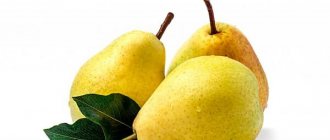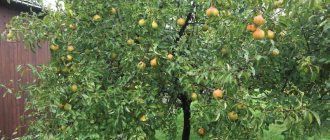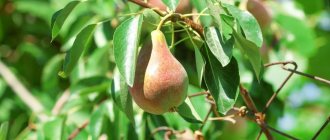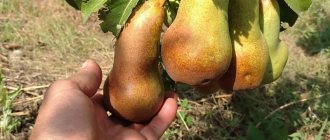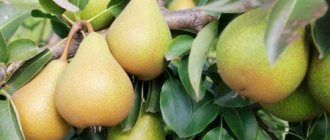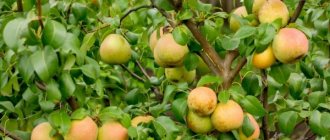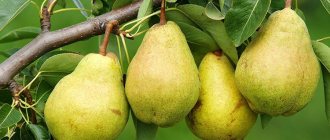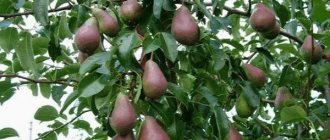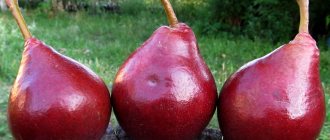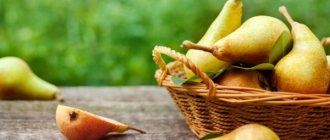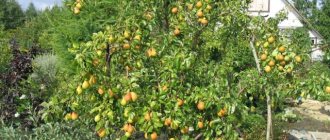Rainbow pear variety.
Description of the variety
Rainbow pear is a summer ripening variety. The trees can withstand frosts down to -37.2 degrees Celsius and are successfully grown in many areas of the country.
The pear received this name, Rainbow, for the beautiful appearance of the fresh fruit. The green skin turns yellow at maturity, with beautiful red ruddy sides.
Characteristics of wood
Depending on different climatic conditions, trees of this variety can be strong or medium-sized. The crown is medium dense, has a round, slightly oblong shape. The bark on the shoots has a brownish-green tint. The leaves are rich green, oblong. The surface of the leaf plate is smooth and shiny.
Description of fruits
Rainbow fruits.
Medium to above medium sized pears. The weight of one fruit is 140-180 grams. The pear shape is standard. The main color of the ripe fruit is yellow. There is a slight pink blush on the sunny side of the pear.
The fruits are tender, juicy, and have a sweet, dessert taste.
The ripening period of the harvest depends on weather conditions and occurs in early August or early September. The fruits do not tolerate transportation well and retain their consumer qualities for up to 10 days.
Rainbow pear variety
Raduzhnaya is a summer pear variety bred at the State Scientific Institution YuUNIIPOK (Chelyabinsk) together with the Sverdlovsk Horticultural Breeding Station (Ekaterinburg) through crossing seedling 41−15−9 with Forest Beauty. The seedling 41−15−9 itself was obtained by P.A. Zhavoronkov by hybridizing a selected form of the Ussuri pear Blagoveshchenskaya with Limonovka Issykkulskaya. The authorship belongs to a group of breeders headed by E.A. Falkenberg (in 1989 he carried out a pomological description of the variety).
The trees of this pear are medium-sized, the crown is moderately spreading, the shape is round (in the conditions of Chelyabinsk) or wide-pyramidal (in the conditions of Yekaterinburg).
The level of self-fertility is low. The following varieties are recognized as the best pollinators for Raduzhnaya: Krasulya, Severyanka, Skazochnaya.
The fruits grow to large sizes (average weight is 130 - 140 grams), round, slightly cuboid in shape. The main color of the fruit is green, when ripe it is yellow-green; cover color - elegant red blush. The skin is tender. The pulp is juicy, with a good sour-sweet taste, dessert type (tasting score 4.2 - 4.5 points). According to the chemical composition, the fruits contain: dry matter (12.1%), total sugars (8.4%), titratable acids (0.13%), ascorbic acid (6 mg/100 g). The main purpose of the fruit is fresh consumption and processing into juices.
Fruit ripening is uniform, occurring in the same period as in Severyanka, or 2 - 3 days later. The main sign of ripening is yellowing of the skin. Moreover, the seeds of ripe fruits are white. Until full ripening, the pears are firmly held on the branches and do not fall off. The total storage period of the fruit does not exceed 10 days, after which the process of softening and drilling of the pulp begins.
The early fruiting of the Rainbow pear is good, the trees begin to bear fruit from the 4th year and quickly increase the volume of the harvest (in the 6th year of life the tree produces up to 16 kg of fruit). Fruiting is annual. The yield is high (higher than the control variety - Severyanka). The average yield for the first 5 years of fruiting was 21.7 kg/tree. (or 9.0 t/ha), for 1989 - 30 kg/tree, for 1990 - 36.6 kg/tree.
This variety is highly winter-hardy (according to SSSS - approximately at the level of Sverdlovsk varieties, according to YuUNIPOK - at the level of Severyanka). The frost resistance level is set to minus 37.2 °C. In the harsh winter of 1978 - 1979, when the air temperature dropped to minus 48.3 °C, the mother tree froze to 2 points, and young trees in the competitive study - to 3 points. No lunges were observed. The variety's drought resistance level is average. Resistance to pear gall mite, scab and fire blight is high.
Rainbow is well grafted and grows on Ussuri pear seedlings. The best soil is leached chernozem, medium-dense. The best location for relief is the middle and upper third of a gentle slope. It is recommended to carry out formative pruning on trees up to 3 years old, and then on sanitary pruning.
The main advantages of this pear include: fruits with good presentation and dessert taste, a high level of winter hardiness and resistance to a number of diseases and pests.
Speaking about the disadvantages of the variety, it is worth noting that in dry years there is a small amount of growth and “shallowing” of the fruits (i.e., a decrease in their weight).
Reviews
Dmiry
Chelyabinsk
The tree has not grown very tall, but thanks to this it is easy to harvest from it. There are always a lot of fruits on my pear, but if you don’t have another variety growing on your plot with a similar flowering period, the yield will be much lower.
Veronica
Kostroma
The pear is very hardy and can withstand prolonged winter frosts without problems. I covered the tree for the winter only in the first few years after planting, but now I just mulch the tree trunk and no problems arise.
Igor
Penza
The fruits of this variety are quite large and incredibly tasty. The harvest does not last long, like most other summer varieties, but this is not a problem. My wife makes excellent jam from pears.
Reviews from gardeners
The early fruiting and frost resistance of the variety have made it quite popular and promising for cultivation . When growing Rainbow, gardeners willingly share their comments and observations.
Vitaly, Krasnoturinsk
When the pear tree began to bear fruit for the first time, I wanted to cut it down. The harvest turned out to be too small compared to what was promised. Then I decided to wait another year and was right. It turned out that the harvest is increasing all the time, every year. I wonder if I can collect a ton? As for the safety of the pears, I pick the green ones and put newspaper between them. Just no more than 2 layers of pears, otherwise they will choke. And nothing, they lie on the veranda almost until the New Year.
Nectarine, Revda
On my site, the ground for trees and shrubs is leached. I read about Raduzhnaya, her demands, and thought that she would disappear. But it turned out quite the opposite: the beautiful pear grew. It’s just too high, we can remove it with a long pole. Very pleased.
Nadezhda, Mikhailovsk
I read a lot of good things about this variety and decided to also add a couple of lines. Everyone admires frost resistance, a generous harvest, complains about poor storage, and is indignant about agricultural technology. I will say this - they are lazy, they don’t want to work, they want to have something to eat, but they won’t feed the poor tree. The care is not so scary and difficult in comparison with the result obtained. Rainbow is generous with gratitude. All negative reviews, I believe, are written by lazy people. And trees, like little children, need care.
Konstantin, Yugorsk
In the fall I planted a couple of Rainbows. I read that it is very frost-resistant. So I hoped on chance, I didn’t cover the seedlings for the winter. Soon it began to rain and frost hit. And so the pears stood frozen until spring. I thought that was it. I don't see pear grace. Only in the spring did the trees thaw, buds appear, and then completely turn green. I did not expect such a miracle. This is what frost resistance means.
Landing
Rainbow adapts well to different conditions and the technology for planting seedlings of this pear is no different from other varieties. By clicking on the links below, you can familiarize yourself with detailed instructions for planting seedlings of the Raduzhnaya variety.
How to plant a pear tree correctly
At what distance to plant pears?
How to choose pear seedlings
How to replant a pear
Harvest and storage
Pears are always picked before they are fully ripe. If you leave them on the tree, they will ripen, soften and lose transportability. Such fruits cannot be stored for more than a couple of weeks. At the stage of technical maturity, all pears are green. As they ripen, they acquire the color that corresponds to the variety. To determine whether to harvest, place your hand under the fruit and tilt it horizontally.
If it comes off the branch, it's time to harvest. Harvested pears are stored in baskets, boxes or boxes. Place them in one layer or two, but interleaved with paper to prevent the fruits from rubbing against each other. Pears damaged by insects, deformed or hit are not placed in boxes, but are processed immediately after harvest.
Video: when and how to harvest pears
The Samara Beauty variety is distinguished by beautiful, tasty fruits and high yield. In addition, it is easy to care for and does not require a pollinator companion, so it is quite suitable for growing both in a personal plot and for the gardens of large agricultural enterprises.
Care
Pears of this variety do not require special care. For successful growth and development of a tree, standard agricultural technology is sufficient. Useful recommendations for growing Rainbow pears can be found in the articles selected below.
How to care for a pear Pruning a pear Pruning a columnar pear Treating a pear from diseases and pests Feeding a pear How to water a pear
Features of culture
- Wild ancestors gave the pear variety “Rainbow” high frost resistance. Freezing of wood begins at -37 degrees, but it is not significant. If the temperature outside is below 40 degrees below zero, the shoots freeze 2 points.
- If the autumn was warm, and then severe frosts suddenly set in, then in the spring the tree will slowly come out of dormancy - this is its varietal feature.
- Drought resistance is average. The tree will tolerate a lack of moisture, but this will not affect the quality of growth and the size of the fruit for the better.
- One of the advantages of the “Rainbow” variety is its high resistance to scab and other fungal diseases. The tree is not affected by the pear gall mite.
Agricultural technology is the same as for other pear trees: watering, loosening the trunk circle, fertilizing. It is important to choose the right place for planting:
- on a not steep slope oriented to the south, it is better in its upper or middle third;
- illuminated throughout the day;
- with protection from cold winds;
- low standing groundwater.
This tree is not demanding on soil quality, but grows better in medium-density, fertile soil with a neutral reaction.
The variety has existed for about 40 years and has proven itself well among gardeners in the middle zone, the North-West and especially the Urals. It was not sent for testing, so “Rainbow” is not listed in the State Register.
To summarize, the main advantages of the crop include: good quality of fruits, resistance to diseases and some pests, frost resistance, the ability to grow on not very fertile soils with moderate watering.
Poor transportability, short shelf life, reduction in fruit weight during drought are the main disadvantages of the variety.
Diseases and pests
Trees of the Raduzhnaya variety have good disease resistance, but still require periodic preventive measures. In the selection of articles below, you can find useful materials and tips on plant protection.
Dangerous Pear Pests
Pears often suffer from pests, they affect the leaves, bark and fruits.
In this article, we have selected 11 of the most harmful insects that harm pear trees, and also ways to destroy them.
Diseases of pear trees
To get what they cherish, gardeners have to work hard, and the reason for this is pear diseases.
Read about 19 common pear diseases and how to combat them.
Planting and care
Although the hybrid is quite unpretentious, its high productivity depends on proper agricultural technology. The following requirements must be met:
- When choosing a site for planting, you should choose an option with deep groundwater, plenty of sun, and protection from the winds.
- The soil should contain sand and a small amount of clay.
- It is recommended to plant only two-year-old seedlings.
- The soil must be loose enough to satisfy the oxygen needs of the tree's roots.
- The root collar must rise above the ground.
- The planted tree is watered to compact the soil and optimize moisture.
Advice! The seedling needs to be tied to a stake.
Landing
Proper planting of seedlings is carried out in the fall. In the first winter, they are carefully insulated using straw and spruce branches. They even wrap it in film.
Before planting pears, a half-meter layer of soil is selected from the hole and mixed, adding manure or peat. In case of high acidity, it is necessary to add lime and ash. All of the removed soil is then placed back into the hole, filling it to the brim.
Next, a stake is driven into the middle of the hole and a seedling is placed. The neck must be raised above the level. Then the earth is compacted and watering is carried out - about a couple of buckets, but gradually, giving the water time to absorb.
Watering
Rainbow loves water very much. It is recommended to water it by sprinkling, irrigating the foliage. Sprayers are perfect for this purpose. For mature trees, gardeners have gotten used to mounting them on poles. Most often, in the absence of running water, they make an irrigation ditch.
During the dry season, the amount of water and frequency of watering are increased. You just can’t fill the pear either. Saturation with moisture will have a bad effect on the development of the crop, roots are inhibited, and resistance to disease is reduced.
With a lack of water, the foliage quickly ages and the life span of the plant is shortened.
Feeding, pruning
No less than in water, Rainbow needs feeding. The harsh climate forces the pear to consume a lot of nutrients. Incorrect regime: both a deficiency and an excess of minerals are equally dangerous for the tree.
Experts advise that when cultivating a hybrid, you should devote enough time and attention to proper pruning. First, the standard formative pruning for all pears is carried out, and then only sanitary pruning. As a result, you will get a healthy and fruitful tree.
It is extremely important to regularly inspect the tree and apply protective equipment in a timely manner.
Caring for the Rainbow is quite simple. The hybrid has good immunity to some diseases, but the plant cannot be ignored. There are a lot of pests left, eager to get to the pear:
- Scab may appear in spring, marking the leaves with a green-gray coating;
- Fruit rot spores can become airborne;
- Powdery mildew damages inflorescences, buds, shoots and foliage.
We should also not forget about the possible attacks of numerous insects wanting to profit from the tree.
Pear care
Caring for the Otradnenskaya pear is simple. In order for the plant to develop properly and produce a bountiful harvest, no special skills are needed. But there are still some features that should be adhered to
These should be taken into account by those just starting out in gardening.
The pear does not like excessively wet soil, so the optimal frequency of watering is once a month. If the weather is rainy, you should irrigate even less often.
Basic rules for plant care:
- Insect treatment. At the very beginning of spring, until the tree begins to form buds, it is sprayed for preventive purposes. Treatment with an ammonia solution at a concentration of 10% gives good results. Before flowers bloom and immediately after flowering, the tree is treated with insecticides to protect the pear from codling moths, mites, and flower beetles.
- Watering the tree. The first year after planting, the young tree must be watered regularly. The soil should not dry out, otherwise the seedling will disappear. Also, after each irrigation, the soil around the trunk is loosened, this will protect it from rapid evaporation of moisture.
- Feeding. In the autumn period of the year, fertilizers are necessary for the formation of wood, which, in turn, helps the tree to overwinter well. For feeding at this time, preparations based on potassium and phosphorus are most suitable. In the spring, the pear is fed with nitrogen mixtures and organic matter.
As for pruning, it is simply necessary for the Otradnenskaya pear. The first procedure is carried out immediately after planting. Annual specimens are trimmed so that their height is no more than a meter. Shoots in the lower half of the tree are also removed.
The next year, the exact same procedure is carried out. Two-year-old seedlings undergo less pruning - only a third of their height. Due to this, the tree will receive an incentive to form a strong root system.
If you follow simple rules for planting and caring for the Otradnenskaya pear, the tree will definitely reward you with a good harvest. The fruits will grow beautiful and very tasty.
Agricultural technology
Despite the fact that the Raduzhny variety is quite unpretentious, for the full development of the tree the following agrotechnical techniques should be used:
- Planting seedlings two years old in spring or autumn.
- Planting seedlings in loose and pre-fertilized soil, which will provide the root system with good air exchange.
- The soil in which the seedling is planned to be planted should include river sand and clay.
- The optimal place for a pear is a well-lit area without drafts or nearby groundwater.
- The place where the pear root system meets the trunk should be 5-6 cm above the soil level.
- After planting the seedling, it is recommended to water it to moisten the soil and compact it.
